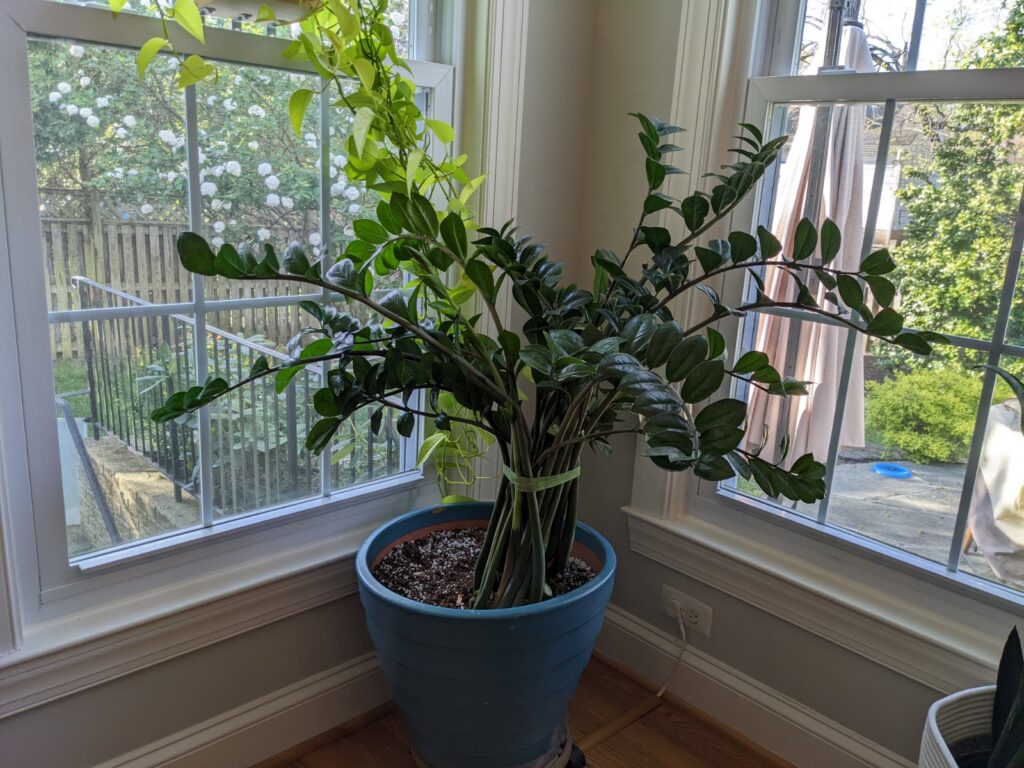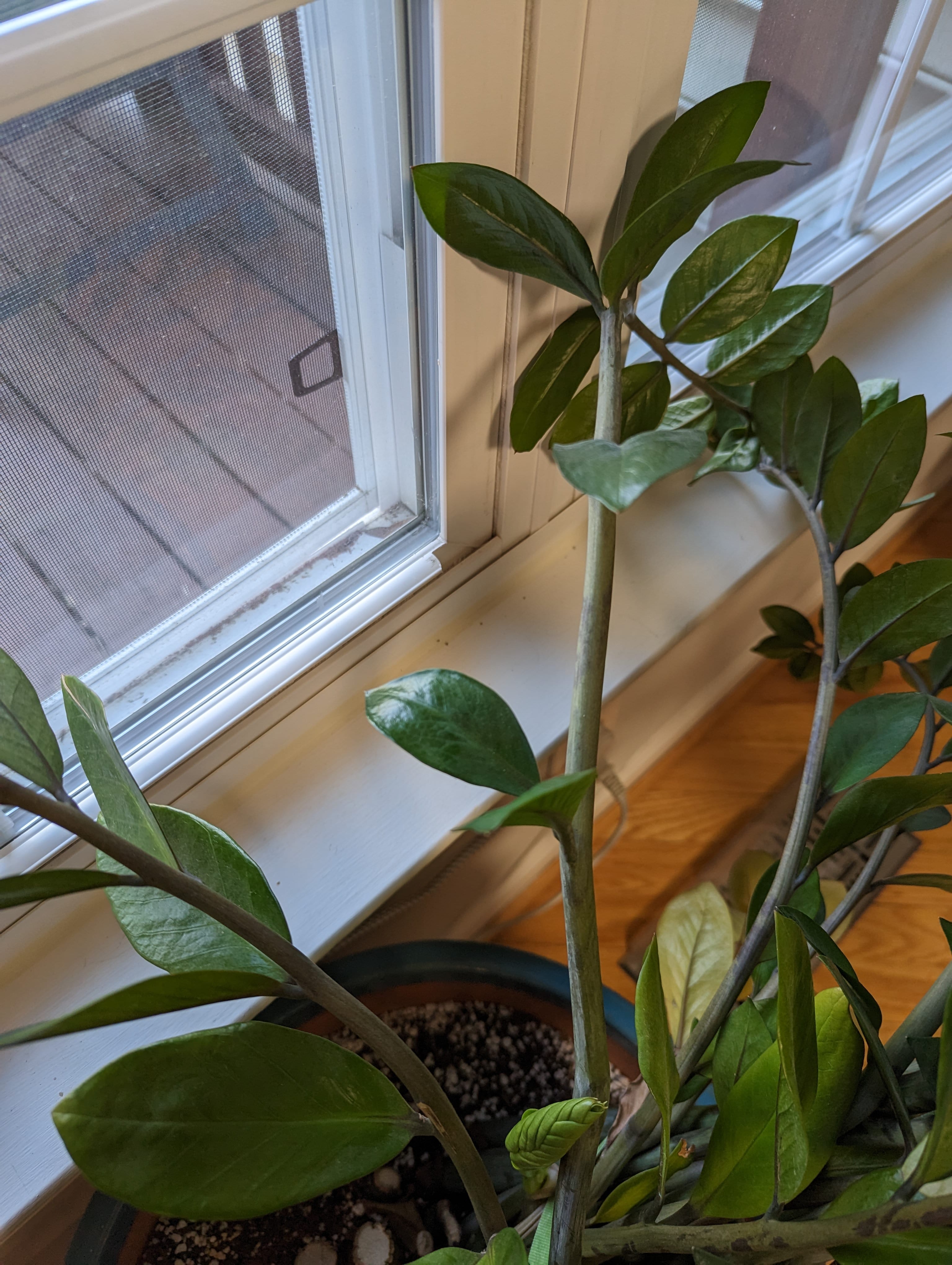ZZ Plants are quite popular as houseplants. They sport dark glossy leaves on plump stems. ZZ Plants can grow quite large, but they grow relatively slowly compared to most houseplants. I have a large one that is nearly four feet in diameter (see below). They are touted as one of the easiest houseplants to care for, partly due to their light needs. They are known as low light plants, but what does that mean? Are ZZ plants low light? Follow along to learn more.

ZZ Plant Low Light?
ZZ Plants grow best in indirect light. A north or east-facing window is the best place to provide your ZZ Plant with indirect light. North-facing windows receive ambient light from other directions, but no direct sunlight. In addition, the sun rises in the east, so the light coming from that direction is less intense compared to the south and west windows.
If you want to put your ZZ Plant in a brighter spot, there are some ways to make sure the light is less intense, or indirect. If you place it in a window with bright direct light, make sure that window has some sheer shades or some trees outside that filter the light. That should be sufficient to make the light indirect. Indirectness is especially important if you put it in a south-facing window. A south-facing window gets the most intense sunlight for the longest amount of time compared to other window directions. Another option is to keep your ZZ Plant further from the window to help reduce the light’s intensity as well.
ZZ Plant Light Changes
If you plan to move your ZZ Plant to a different location, take a moment to consider the light differences between the two locations. If it will receive more or less sunlight, then you should acclimate it to the new spot. For example, when you first bring a plant home from the store. That’s a time when the light change will likely be large, especially if it was inside a store with limited sunlight. Another example maybe if it is next to a window and you want to move it further away. A ZZ Plant that has been moved to a spot where it receives drastically more or less sunlight too quickly may end up exhibiting signs of shock.
Shock can show up as different symptoms which I’ll discuss more in the next sections. To avoid shock, you should move your ZZ Plant gradually to any new spot to acclimate it. If you’re looking for a rule to follow, it’s safe to move your plant about a foot a day toward the new spot. Some people move their ZZ Plants outside for the summer. If you’re interested in that, then follow these tips. Expose your ZZ Plant to the outdoor levels of sunlight for only a few hours a day in the beginning. Then gradually increase the number of hours each day, by an hour or two until it can be left outside 24/7. This could take a week.
ZZ Plant Not Receiving Enough Light
ZZ Plants are known as lower-light plants, but it is possible for them to get too little light. A ZZ Plant that has not been getting enough light will grow stems that are stretched out and thinner than normal. Another visual cue is that there will be more space in between the leaves on the stretched-out stems compared to others on the plant. See the picture below for an example, the middle stem developed when this ZZ plant wasn’t getting enough light. Stretched-out growth is called etiolation and it’s unhealthy.

Some people worry that slow growth means their ZZ Plant is not receiving enough sunlight. While that could be possible, I want to stress that ZZ Plants grow quite slowly. In a single growing season, spring through early fall, a ZZ Plant may only put out one or two new stems and that would be completely normal.
ZZ Plant Sunburn
Sunburn is less common for ZZ Plants kept indoors full-time, but it’s possible. Sun damage is most likely to occur on a ZZ Plant that has been moved outside for the summer. If you summer your ZZ Plant outdoors, you must acclimate it to the outdoor sun gradually. Although sunburn is not ideal, it will rarely completely kill a ZZ Plant. You will have some unsightly leaves though. What does sunburn look like? Leaves with dry brown or yellow spots on the leaves. These dry spots will happen anywhere on the leaf surface, not just the tips. If you’re seeing discoloration just on the tips of the leaves, that’s more likely a water issue. Sunburned can also make leaves appear pale or bleached out. Sunburn is most likely to show up on the topmost leaves that are receiving the most direct light.
Plant Light Meters
If you are genuinely interested in light levels and love data, I highly suggest this light meter. This monitor measures light, moisture, and nutrients. In this price range, it is superior to most light meters because it lets you track the accumulation of light by the hour. In other words, it tracks how intense the light was each hour of the day, for however long you want to track via the app. That’s important because both intensity and duration matter for plant growth. Most other light meters do not have a passive recording, so you only know the measurement when you are physically looking at the meter. Read my in-depth write-up on this plant monitor if you’re interested in learning more.
Do you have other ZZ Plant questions? Share in the comments.

I'm a long time plant lover on the quest to happily coexist with as many plants as I can. Let's grow!
